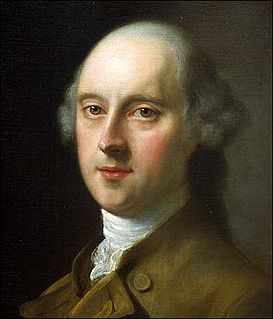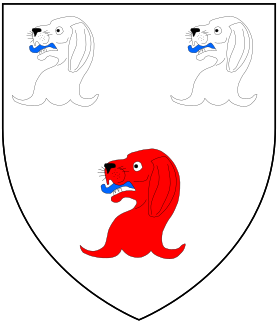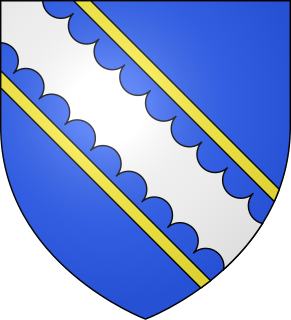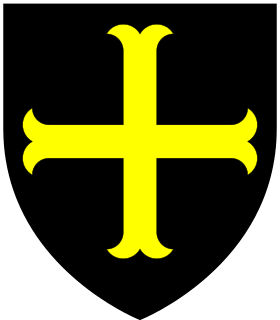
Marquess Townshend is a title in the Peerage of Great Britain held by the Townshend family of Raynham Hall in Norfolk. The title was created in 1787 for George Townshend, 4th Viscount Townshend.

Marquess of Ailesbury, in the County of Buckingham, is a title in the Peerage of the United Kingdom. It was created on 17 July 1821 for Charles Brudenell-Bruce, 2nd Earl of Ailesbury.

William Legge, 2nd Earl of Dartmouth, PC, FRS, styled as Viscount Lewisham from 1732 to 1750, was a British statesman who is most remembered as the namesake of Dartmouth College.

Earl of Strafford is a title that has been created three times in English and British history.

Baron Feversham is a title that has been created twice, once in the Peerage of Great Britain and once in the Peerage of the United Kingdom. The first creation, in the Peerage of Great Britain, came in 1747 when Anthony Duncombe, who had earlier represented Salisbury and Downton in the House of Commons, was made Lord Feversham, Baron of Downton, in the County of Wilts. He had previously inherited half of the enormous fortune of his uncle Sir Charles Duncombe. However, Lord Feversham had no sons and the barony became extinct on his death in 1763. The peerage was revived in the Peerage of the United Kingdom in 1826 in favour of his kinsman Charles Duncombe, who was created Baron Feversham, of Duncombe Park in the County of York. He was a former Member of Parliament for Shaftesbury, Aldborough, Heytesbury and Newport. Duncombe was the grandson of Thomas Duncombe, son of John Brown by his wife Ursula Duncombe, aunt of the first Baron of the 1747 creation. Ursula had inherited the other half of her brother Sir Charles Duncombe's fortune. Lord Feversham son, the second Baron, sat as a Conservative Member of Parliament for Yorkshire and the North Riding of Yorkshire.

Earl Fitzwilliam was a title in both the Peerage of Ireland and the Peerage of Great Britain held by the head of the Fitzwilliam family.

Baron Clermont is a title that has been created three times, twice in the Peerage of Ireland and once in the Peerage of the United Kingdom. All three creations are extinct. The first creation, Baron Clermont, of Clermont in the County of Louth, came in the Peerage of Ireland on 26 May 1770 for William Fortescue, who was later made Viscount Clermont and Earl of Clermont. For more information on this creation see Viscount Clermont, a title which became extinct in 1829. The second creation came in the Peerage of Ireland on 11 February 1852 when Thomas Fortescue, formerly Member of Parliament for Louth, was made Baron Clermont, of Dromisken in the County of Louth, with special remainder failing heirs male of his own to his younger brother Chichester Fortescue and the heirs male of his body.

The Birmingham and Midland Institute, is an institution concerned with the promotion of education and learning in Birmingham, England. It is now based on Margaret Street in Birmingham city centre. It was founded in 1854 as a pioneer of adult scientific and technical education ; and today continues to offer arts and science lectures, exhibitions and concerts. It is a registered charity. There is limited free access to the public, with further facilities available on a subscription basis.

George Cecil Weld-Forester, 3rd Baron Forester PC, styled The Honourable George Weld-Forester between 1821 and 1874, was a British Conservative politician and army officer. He notably served as Comptroller of the Household in 1852 and from 1858 to 1859. A long-standing MP, he was Father of the House of Commons from 1873 to 1874, when he succeeded his elder brother in the barony and took a seat in the House of Lords.
Thomas Knox, 1st Earl of Ranfurly, styled The Honourable Thomas Knox between 1781 and 1818 and known as The Viscount Northland between 1818 and 1831, was an Irish peer and politician.
Thomas George Southwell, 1st Viscount Southwell, styled The Honourable from birth until 1766, was an Irish politician and freemason.
The Coronation Honours 1911 for the British Empire were announced on 19 June 1911, to celebrate the coronation of George V which was held on 22 June 1911.

John Henry Upton, 1st Viscount Templetown, styled The Honourable John Upton between 1776 and 1785 and known as The Lord Templetown between 1785 and 1806, was an Anglo-Irish politician.
The 1902 Birthday Honours were announced on 10 November 1902, to celebrate the birthday of Edward VII the previous day. The list included appointments to various orders and honours of the United Kingdom and the British Empire.
The 1902 Coronation Honours were announced on 26 June 1902, the date originally set for the coronation of King Edward VII. The coronation was postponed because the King had been taken ill two days before, but he ordered that the honours list should be published on that day anyway.
The 1885 Dissolution Honours List was issued in June 1885 prior to the general election of that year.
The 1892 Dissolution Honours List was issued in August 1892 following the general election of that year.

The 1821 Coronation Honours were appointments by King George IV to various orders and honours on the occasion of his coronation on 19 July 1821. The honours were published in The London Gazette on 14, 24 and 28 July 1821.
The 1875 Birthday Honours were appointments by Queen Victoria to various orders and honours to reward and highlight good works by citizens of the British Empire. The appointments were made to celebrate the official birthday of the Queen, and were published in The London Gazette in May and June 1875.










